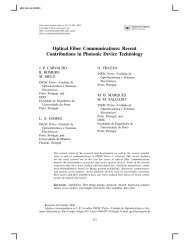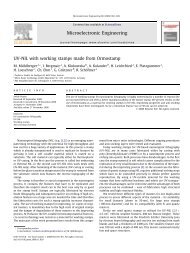Photosensitive Materials for Integrated Optic ... - ResearchGate
Photosensitive Materials for Integrated Optic ... - ResearchGate
Photosensitive Materials for Integrated Optic ... - ResearchGate
You also want an ePaper? Increase the reach of your titles
YUMPU automatically turns print PDFs into web optimized ePapers that Google loves.
154 P. V. S. Marques et al.<br />
Figure 3. Evolution of peak reflectivity <strong>for</strong> the grating characterized in Figure 2.<br />
has high lanthanide solubility. A schematic representation of the structure fabricated is<br />
represented in Figure 4.<br />
The waveguides were also fabricated by flame hydrolysis deposition and reactive ion<br />
etching. Initially, a 2-µm photosensitive layer was deposited on top of a 15-µm-thick pure<br />
oxide undercladding, obtained by silicon oxidation. This photosensitive layer was doped<br />
with germanium and boron. A second core layer, 4-µm thick, was then deposited and<br />
consolidated. This layer was doped with neodymium and used a phosphorous/aluminumbased<br />
silica host, produced by aerosol doping techniques [18]. The Nd 3+ concentration<br />
is estimated to be ≈0.21 wt% by comparison with measured samples produced under<br />
similar conditions [18]. The core ridges were <strong>for</strong>med by photolithographic processes and<br />
RIE and covered with an overcladding layer with the refractive index matching that of the<br />
thermal oxide buffer. The total core thickness is 6 µm and the relative index difference to<br />
the adjacent layers is 0.75% (the two core layers were index matched). The total sample<br />
length is 5 cm.<br />
Figure 4. Schematic representation of the laser structure.





